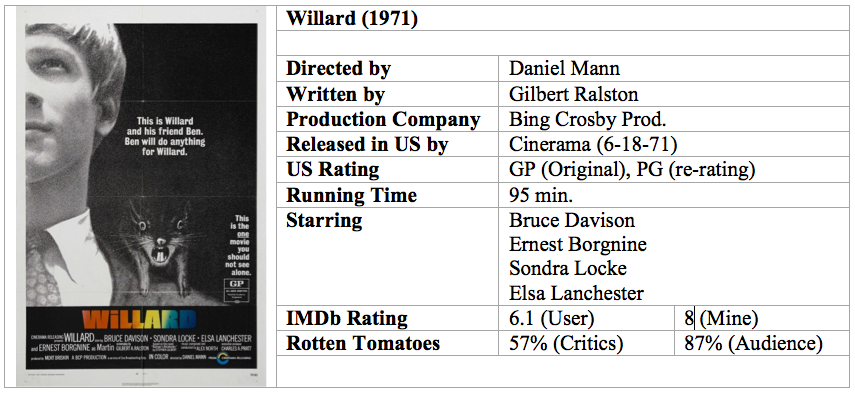We learn everything we need to know about Willard Stiles (Bruce
Davison) in the opening scenes of the movie Willard. He forgets papers at work, misses his bus and
is smothered at home. His mother’s friends tell him he’s an extrovert, “but
it’s all inside”, and verbally harass him about being tougher. Yeah, he’s a real loser. However, he’s a sympathetic loser. Each time the man is knocked down, suspense
builds toward the inevitable moment when he will fight back.
In 2014, the method for his revenge may not seem terribly original,
but when Willard was first released in 1971, it was quite unsettling. In the back yard that he is supposed to clean
up for his sick mother (Elsa Lanchester), he befriends two rats, Ben and
Socrates. He trains them and their growing
number of friends and family until his cellar is virtually teaming with the
creatures. Feeding them, taking them to
work, he ultimately has them under his control.
He first uses them for a little harmless fun: ruining an anniversary party for his truly
horrible boss, Al Martin (Ernest Borgnine).
He then uses them as a distraction so he can steal the money he needs to
pay back taxes. And finally, he uses
them for murder. As we all know, though,
deeds like this don’t usually go unpunished.
When Willard realizes the errors of his ways, he tries to get out, but
his new friends don’t want it to be that easy.
For a mostly straightforward story like this, Willard is
surprisingly effective, even by today’s standards. I’ll admit it’s a little lighthearted at
first, but once the last straw is placed on the camel’s back, the movie takes a
sinister turn and is scary as heck. The
penultimate scene where Willard confronts Martin in his office is
chilling. Martin opens the door to find
Willard standing there with a multitude of rats swarming over and around his
feet.
There’s something inherently creepy in a movie about rats. Just seeing a rat makes me squirm. And to hear the tiny footsteps of hundreds of
them marching along a wooden floor makes me lift my feet onto my chair. But to have my worst fears about them
realized… that they might attack me… well, it’s almost too much to bear. All that aside, though, the movie contributes
its own creepiness with a disciplined use of camera angles, close-ups and nightmare-like
lighting.
Director Daniel Mann (Butterfield 8, Our Man Flint) maximizes the
thrills with what appears on screen to be a very low budget. But he proves you don’t need a lot of money
to make an effective movie. The screenply
is by television veteran Gilbert Ralston; you name a 60’s TV series and he
likely wrote an episode of it, including Star Trek (Who Mourns for
Adonais?) It’s based on the novel,
“Ratman’s Notebooks,” by Stephen Gilbert.
I’d love to read the book sometime.
Besides the chilling scenes are a couple filled with dark
humor. When Willard’s mother dies and
her friends bring food to the house, they swarm around the dinner table, eating
like a bunch of hungry rats. Willard
stands back and watches. Never before
disgusted with his friends that are literally rats, he looks like he’s going to
be physically sick watching these people stuff their faces (while at the same
time, by the way, ignoring him.
It’s also an intentionally humorous moment when a potential romance
at the office, played by Sondra Locke what was only her third screen role,
gives Willard a gift: a cat. After dropping her off, she tells him to take
care of it. He replies, “I’ll take care
of her all right.” Don’t worry; this is
during the early, innocent part of the movie.
He doesn’t feed it to the rats.
Instead, he asks a man in a phone booth to hold it for a moment, then
quickly drives away.
Willard is more dated than most of the 70s horror movies I’ve been
watching this month, and I don’t mean in a scene where a shocked secretary
exclaims, “Can you imagine having $8,000 to spend on a vacation.” (Wait a minute; I’m not sure I can imagine
that. That’s still a lot of money in
2014.) I’m talking about a scene after
Martin’s anniversary party erupts in chaos.
Mocking one of his employees, he says, “You should have seen this ‘hero,’
up on a chair screaming like a fag.”
Near the end of the movie, Willard channels Norman Bates and talks
to a framed photo of his mother. “Martin
killed Socrates just like he killed my father.
It doesn’t matter; I make the decisions now.” So it’s really all about power and
control. Willard doesn’t have it. Then he thinks he does. But it isn’t too long before he has to
unconvincingly say to his rats, “Each time I come down here there are more of
you. Stop it. I am the boss here.” The lesson is brewing…
Willard must have been successful at the box office (and I don’t
imagine it had to make much more to be profitable), because there was a
Willard-less sequel called Ben. You’re
probably more familiar with its theme song by a young artist named Michael
Jackson than you are with the movie.
Just think about this the next time you hear the sweet melody: he’s singing about a rat. (I’ve been unable to locate a copy of Ben to
review.)
Willard remains important today if for no other reason than because of
its cast. Sondra Locke later became Mrs.
Clint Eastwood. Elsa Lanchester was the
original Bride of Frankenstein. Ernest
Borgnine was an Academy Award winner.
And you’ve seen the great character actor Bruce Davison in any number of
the 207 films in which he’s appeared.
But you’ve never seen the skinny, awkward and, yes, mousy Bruce Davison
until you’ve seen him in Willard.






No comments:
Post a Comment